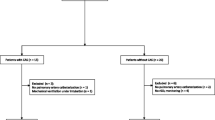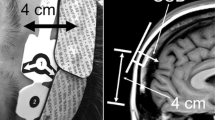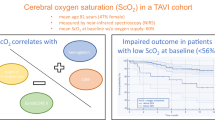Abstract
Deterioration of cerebral performance remains a major problem after cardiac surgery. Axillary artery cannulation can improve clinical outcome, but some experimental series show a malperfusion of the right hemisphere. The aim of our clinical study was to analyze the intraoperative investigation of cerebral oxygenation in two different arterial cannulation sites by use of near-infrared spectroscopic oximetry (NIRO). We compared retrospectively the cerebral saturation of 20 patients with aortic cannulation (group AoC) and 20 patients with right axillary artery cannulation (group AxC) during either valve, coronary artery bypass graft (CABG), combined procedures, or aortic surgery. Patients were monitored with bihemispheric NIRO (NIRO-200, Hamamatsu, Herrsching, Germany). The oxygenation data were calculated as tissue oxygenation index (TOI). And the cardiopulmonary bypass time was considered with special regard to potentially dangerous phases for cerebral desaturation like the starting of the extracorporeal circulation (ECC), cross-clamping, rewarming phase, aortic declamping, and stopping of ECC. Patients were then postoperatively evaluated by a standardized neurological examination. During the entire CPB time and the specific phases potentially at risk for cerebral desaturation, no statistically significant drop of cerebral oxygenation (>20 % for >60 s) was detected after aortic and right axillary artery cannulation, respectively. Furthermore, no significant difference in TOI was found comparing the left and right hemisphere in each group. Postoperatively 2 transient confusional syndromes (CS) were observed after aortic and 3 CS after axillary artery cannulation. Right axillary artery cannulation provides balanced cerebral oxygenation in both hemispheres during extracorporeal circulation and its specific phases potentially at risk for cerebral malperfusion. It might therefore reduce the risk of neurological injury by reduction of solid embolization and maintenance of balanced cerebral oxygenation.

Similar content being viewed by others
References
Grogan K, Stearns J, Hogue CW (2008) Brain protection in cardiac surgery. Anesthesiol Clin 26(3):521–538
Izumi Y, Hayashi M, Morimoto R, Cheng XW, Wu H, Ishii H, Yasuda Y, Yoshikawa D, Izawa H, Matsuo S, Oiso Y, Murohara T (2014) Impact of circulating cathepsin K on the coronary calcification and the clinical outcome in chronic kidney disease patients. Heart Vessels. doi:10.1007/s00380-014-0570-z
Kaneko H, Yajima J, Oikawa Y, Tanaka S, Fukamachi D, Suzuki S, Sagara K, Otsuka T, Matsuno S, Funada R, Kano H, Uejima T, Koike A, Nagashima K, Kirigaya H, Sawada H, Aizawa T, Yamashita T (2014) Effects of statin treatment in patients with coronary artery disease and chronic kidney disease. Heart Vessels 29(1):21–28
Senmaru T, Fukui M, Tanaka M, Sakabe K, Ushigome E, Asano M, Yamazaki M, Hasegawa G, Nakamura N (2013) N-terminal pro-brain natriuretic peptide could be a marker of subclinical atherosclerosis in patients with type 2 diabetes. Heart Vessels 28(2):151–156
Vasques F, Rainio A, Heikkinen J, Mikkola R, Lahtinen J, Kettunen U, Juvonen T, Biancari F (2013) Off-pump versus on-pump coronary artery bypass surgery in patients aged 80 years and older: institutional results and meta-analysis. Heart Vessels 28(1):46–56
Matsue Y, Matsumura A, Abe M, Ono M, Seya M, Nakamura T, Iwatsuka R, Mizukami A, Setoguchi M, Nagahori W, Ohno M, Suzuki M, Hashimoto Y (2013) Prognostic implications of chronic kidney disease and anemia after percutaneous coronary intervention in acute myocardial infarction patients. Heart Vessels 28(1):19–26
Pasic M, Schubel J, Bauer M, Yankah C, Kuppe H, Weng YG, Hetzer R (2003) Cannulation of the right axillary artery for surgery of acute type A aortic dissection. Eur J Cardiothorac Surg 24(2):231–236
Sabik JF, Lytle BW, McCarthy PM, Cosgrove DM (1995) Axillary artery: an alternative site of arterial cannulation for patients with extensive aortic and peripheral vascular disease. J Thorac Cardiovasc Surg 109:885–891
Yilik L, Emrecan B, Kestelli M, Ozsoyler I, Lafci B, Yakut N, Ozbek C, Gurbuz A (2006) Direct versus side-graft cannulation of the right axillary artery. Tex Heart Inst J 33:310–315
Bakhtiary F, Dogan S, Zierer A, Dzemali O, Oezaslan F, Therapidis P, Detho F, Wittlinger T, Martens S, Kleine P, Moritz A, Aybek T (2008) Antegrade cerebral perfusion for acute type A aortic dissection in 120 consecutive patients. Ann Thorac Surg 85(2):465–469
Hedayati N, Sherwood JT, Schomisch SJ, Carino JL, Markowitz AH (2004) Axillary artery cannulation for cardiopulmonary bypass reduces cerebral microemboli. J Thorac Cardiovasc Surg 128(3):386–390
De Smet D, Vanderhaegen J, Naulaers G, Van Huffel S (2009) New measurements for assessment of impaired cerebral autoregulation using near-infrared spectroscopy. Adv Exp Med Biol 645:273–278
Yao FS, Tseng CC, Ho CY, Levin SK, Illner P (2004) Cerebral oxygen desaturation is associated with early postoperative neuropsychological dysfunction in patients undergoing cardiac surgery. J Cardiothorac Vasc Anesth 18(5):552–558
Slater JP, Guarino T, Stack J, Vinod K, Bustami RT, Brown JM 3rd, Rodriguez AL, Magovern CJ, Zaubler T, Freundlich K, Parr GV (2009) Cerebral oxygen desaturation predicts cognitive decline and longer hospital stay after cardiac surgery. Ann Thorac Surg 87(1):36–45
Siminelakis SN, Baikoussis NG, Papadopoulos GS, Beis IP (2009) Axillary artery cannulation for cardiopulmonary bypass during surgery on the ascending aorta and arch. J Card Surg 24:301–304
Gurbuz A, Emrecan B, Yilik L, Ozsoyler I, Lafci B, Kestelli M, Karahan N, Ozbek C (2005) Aortic reoperations experience with 23 patients using axillary artery cannulation. Int Heart J 46:1099–1104
Kokotsakis J, Lazopoulos G, Milonakis M, Athanasiadis G, Romana K, Skouteli E, Bastounis E (2005) Right axillary artery cannulation for surgical management of the hostile ascending aorta. Tex Heart Inst J 32(2):189–193 (discussion 185)
Etz CD, Plestis KA, Kari FA, Silovitz D, Bodian CA, Spielvogel D, Griepp RB (2008) Axillary cannulation significantly improves survival and neurologic outcome after atherosclerotic aneurysm repair of the aortic root and ascending aorta. Ann Thorac Surg 86:441–447
Sinclair MC, Singer RL, Manley NJ, Montesano RM (2003) Cannulation of the axillary artery for cardiopulmonary bypass: safeguards and pitfalls. Ann Thorac Surg 75:931–934
Fleck T, Ehrlich M, Czerny M, Hutschala D, Tschernko E, Mares P, Wolner E, Grabenwoger M (2005) Cannulation of the axillary artery: the decision between direct cannulation and cannulation via side graft. Thorac Cardiov Surg 53:154–157
Sabik JF, Nemeh H, Lytle BW, Blackstone EH, Gillinov AM, Rajeswaran J, Cosgrove DM (2004) Cannulation of the axillary artery with a side graft reduces morbidity. Ann Thorac Surg 77:1315–1320
Svensson LG, Blackstone EH, Rajeswaran J, Sabik JF 3rd, Lytle BW, Gonzales-Stawinski G, Varvitsiotis P, Banbury MK, McCarthy PM, Pettersson GB, Cosgrove DM (2004) Does the arterial cannulation site for circulatory arrest influence stroke risk? Ann Thorac Surg 78:1274–1284
Hillebrand J, Konerding MA, Koch M, Kaufmann T, Steinseifer U, Moritz A, Dzemali O (2013) Anatomic and flow dynamic considerations for safe right axillary artery cannulation. J Thorac Cardiovasc Surg 146(2):467–471
Adhami F, Liao G, Morozov YM, Schloemer A, Schmithorst VJ, Lorenz JN, Dunn RS, Vorhees CV, Wills-Karp M, Degen JL, Davis RJ, Mizushima N, Rakic P, Dardzinski BJ, Holland SK, Sharp FR, Kuan CY (2006) Cerebral ischemia-hypoxia induces intravascular coagulation and autophagy. AJP 169:566–583
Hong SW, Shim JK, Choi YS, Kim DH, Chang BC, Kwak YL (2008) Prediction of cognitive dysfunction and patients’ outcome following valvular heart surgery and the role of cerebral oximetry. Eur J Cardiothorac Surg 33:560–565
Casati A, Fanelli G, Pietropaoli P, Proietti R, Tufano R, Montanini S (2007) Monitoring cerebral oxygen saturation in elderly patients undergoing general abdominal surgery: a prospective cohort study. Eur J Anaesthesiol 24(1):59–65
Goldman S, Sutter F, Ferdinand F, Trace C (2004) Optimizing intraoperative cerebral oxygen delivery using noninvasive cerebral oximetry decreases the incidence of stroke for cardiac surgical patients. Heart Surg Forum 7(5):E376–E381
Harilall Y, Adam JK, Biccard BM, Reddi A (2014) The effect of optimising cerebral tissue oxygen saturation on markers of neurological injury during coronary artery bypass graft surgery. Heart Lung Circ 23(1):68–74
Zheng F, Sheinberg R, Yee MS, Ono M, Zheng Y, Hogue CW (2013) Cerebral near-infrared spectroscopy monitoring and neurologic outcomes in adult cardiac surgery patients: a systematic review. Anesth Analg 116(3):663–676
Kok WF, van Harten AE, Koene BM, Mariani MA, Koerts J, Tucha O, Absalom AR, Scheeren TW (2014) A pilot study of cerebral tissue oxygenation and postoperative cognitive dysfunction among patients undergoing coronary artery bypass grafting randomised to surgery with or without cardiopulmonary bypass*. Anaesthesia 69(6):613–622
Conflict of interest
The authors declare that they have no conflict of interest and state that this manuscript has not been published previously and is not currently being assessed for publication by any other journal than Heart and Vessels. Each Author has contributed substantially to the research, preparation, and production of the paper and approves of its submission to the journal.
Author information
Authors and Affiliations
Corresponding author
Rights and permissions
About this article
Cite this article
Hillebrand, J., Zheng, Z., Ploss, A. et al. Axillary artery cannulation provides balanced cerebral oxygenation. Heart Vessels 31, 1077–1083 (2016). https://doi.org/10.1007/s00380-015-0704-y
Received:
Accepted:
Published:
Issue Date:
DOI: https://doi.org/10.1007/s00380-015-0704-y




